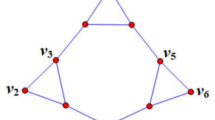Abstract
This paper considers the interplay between semidefinite programming, matrix rank, and graph coloring. Karger et al. (J ACM 45(2):246–265, 1998) give a vector program in which a coloring of a graph can be encoded as a semidefinite matrix of low rank. By complementary slackness conditions of semidefinite programming, if an optimal dual solution has high rank, any optimal primal solution must have low rank. We attempt to characterize graphs for which we can show that the corresponding dual optimal solution must have rank high enough that the primal solution encodes a coloring. In the case of the original Karger, Motwani, and Sudan vector program, we show that any graph which is a k-tree has sufficiently high dual rank, and we can extract the coloring from the corresponding low-rank primal solution. We can also show that if a graph is not uniquely colorable, then no sufficiently high rank dual optimal solution can exist. This allows us to completely characterize the planar graphs for which dual optimal solutions have sufficiently high dual rank, since it is known that the uniquely colorable planar graphs are precisely the planar 3-trees. We then modify the semidefinite program to have an objective function with costs, and explore when we can create an objective function such that the optimal dual solution has sufficiently high rank. We show that it is always possible to construct such an objective function given the graph coloring. The construction of the objective function gives rise to heuristics for 4-coloring planar graphs. We enumerated all maximal planar graphs with an induced \(K_4\) of up to 14 vertices; the heuristics successfully found a 4-coloring for 99.75% of them. Our research was motivated by trying to use semidefinite programming to prove the four-color theorem, which states that every planar graph can be colored with four colors. There is an intriguing connection of the Karger–Motwani–Sudan semidefinite program with the Colin de Verdière graph invariant (J Combin. Theory Ser B 50:11-21, 1990) (and a corresponding conjecture of Colin de Verdière), in which matrices that have some similarities to the dual feasible matrices of the semidefinite program must have high rank in the case that graphs are of a certain type; for instance, planar graphs have rank that would imply that the primal solution of the semidefinite program encodes a 4-coloring.




Similar content being viewed by others
Notes
There are some subtleties here we are glossing over in the interest of getting across the main idea. In particular, the SDP corresponding to the strict vector chromatic number vector program has dimension \(n+1\), not n; we explain why and why that doesn’t matter for our purposes in Sect. 3.
References
Alizadeh, F.: Interior point methods in semidefinite programming with applications to combinatorial optimization. SIAM J. Optim. 5, 13–51 (1995)
Appel, K., Haken, W.: Every planar map is four colorable. part I: discharging. Ill. J. Math. 21, 429–490 (1977)
Appel, K., Haken, W., Koch, J.: Every planar map is four colorable. part II: reducibility. Ill. J. Math. 21, 491–567 (1977)
Brinkmann, G., McKay, B.D.: Fast generation of planar graphs. MATCH- Commun. Math. Comput. Chem. 58, 323–357 (2007)
Colin de Verdière, Y.: Sur un nouvel invariant des graphes et un critére de planarité. J. Combin. Theory Ser. B 50, 11–21 (1990)
Fowler, T.G.: Unique coloring of planar graphs. Ph.D. thesis, Georgia Institute of Technology, Department of Mathematics (1998)
Fritsch, R., Fritsch, G.: The Four-Color Theorem. Springer, Berlin (1994)
Gethner, E., Kallichanda, B., Mentis, A.S., Braudrick, S., Chawla, S.K., Clune, A., Drummond, R., Evans, P., Roche, W., Takano, N.: How false is Kempe’s proof of the four color theorem? part II. Involve J. Math. 2, 249–265 (2009)
Hillar, C.J., Windfeldt, T.: Algebraic characterization of uniquely vertex colorable graphs. J. Combin. Theory Ser. B 98, 400–414 (2008)
Jensen, T.R., Toft, B.: Graph Coloring Problems. Wiley, New York (1995)
Karger, D., Motwani, R., Sudan, M.: Approximate graph coloring by semidefinite programming. J. ACM 45(2), 246–265 (1998). https://doi.org/10.1145/274787.274791
Knuth, D.E.: The sandwich theorem. Electron. J. Combin. 1 (1994). https://www.emis.de/journals/EJC/Volume_1/PDFFiles/v1i1a1.pdf
Lovász, L.: On the Shannon capacity of a graph. IEEE Trans. Inf. Theory IT–25, 1–7 (1979)
Molloy, M., Reed, B.: Graph Colouring and the Probabilistic Method. No. 23 in Algorithms and Combinatorics. Springer, Berlin, Germany (2002)
Ore, O.: The Four-Color Theorem. Academic Press, New York (1967)
Robertson, N., Sanders, D., Seymour, P., Thomas, R.: The four-colour theorem. J. Combin. Theory Ser. B 70, 2–44 (1997)
van der Holst, H., Lovász, L., Schrijver, A.: The Colin de Verdière graph parameter. Graph Theory Combin. Biol. 7, 29–85 (1999)
Wilson, R.A.: Graphs, Colourings, and the Four-Colour Theorem. Oxford University Press, New York (2002)
Acknowledgements
The first and third authors were partially supported by the National Science Foundation [NSF CCF-2007009]. We thank the referees for their useful comments and feedback which improved the paper. Supported by National Science Foundation grant CCF-2007009. We are grateful to the referees for their feedback on an earlier version of this paper.
Author information
Authors and Affiliations
Corresponding author
Additional information
Publisher's Note
Springer Nature remains neutral with regard to jurisdictional claims in published maps and institutional affiliations.
Some of the material in this work also appears in Integer Programming and Combinatorial Optimization, 23rd International Conference, IPCO 2022, Eindhoven, The Netherlands, June 27–29, 2022, Proceedings.
Rights and permissions
Springer Nature or its licensor (e.g. a society or other partner) holds exclusive rights to this article under a publishing agreement with the author(s) or other rightsholder(s); author self-archiving of the accepted manuscript version of this article is solely governed by the terms of such publishing agreement and applicable law.
About this article
Cite this article
Mirka, R., Smedira, D. & Williamson, D.P. Graph coloring and semidefinite rank. Math. Program. (2024). https://doi.org/10.1007/s10107-024-02085-0
Received:
Accepted:
Published:
DOI: https://doi.org/10.1007/s10107-024-02085-0




